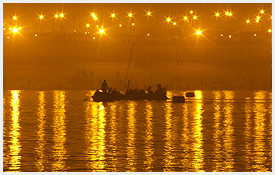» About Haridwar
» About Rishikesh
» About Ujjain
» About Nashik
» About Allahabad
» About Ganga
» About Akharas
» About Ayurveda
» About Yoga
» About Festivals
»About Kumbh Mela
» Ardh Kumbh
» Haridwar Information
» Haridwar Tourist Information
» Ayurveda Tours
» Chandrashilla Sumit Trekking
» Dehradun Mussoorie
» Dodi Tal Trekking
» Gangotri Trek Tour
» Golden Triangle Tour
» Har Ki Dun Trek
» Haridwar Rishikesh Jaipur Tour
» Chardham Pilgrimage
» Kumbh Itinerary Detail
» Footstep Lord Buddha
» Jain Yatra Kutchh
» Kailash Darshan By Foot
» Kailash Darshan By Helicopter
» Lhasa Kailash Mansarovar Yatra
» Muktinath Darshan Yatra

Home - About Ganga
About Ganga

The sanctified Ganga River originates in the Himalayas Other Names : Bhagirathi, Alaknanda, Dhauliganga, Padma, Mandakini
Countries : India, Bangladesh
Major cities : Haridwar, Kanpur, Allahabad, Varanasi, Patna
Length : 2,510 km
Watershed : 907,000 km²
Source : Gaumukha, Gangotri Glacier located in Uttarakhand, India
Destination : Ganges Delta located in Bay of Bengal, Bangladesh
Major Tributaries: In the left, Brahmaputra, Gomti, Kosi, Gandak, Ghaghra In the right Yamuna, Son
It begins at the Gangotri Glacier in the state of Uttarakhand in the central Himalayas at the confluence of five headstreams - the Bhagirathi, Mandakini, Alaknanda, Dhauliganga and Pindar at Devaprayag. From here, it drains into the Bay of Bengal through its vast delta in the Sunderbans and also into Bangladesh. After entering Bangladesh, the main branch of the Ganges is known as Padma River till the Jamuna River the largest distributary of the Brahmaputra joins it. The river has been of supreme importance for Hinduism.
This is shown as the mother of one of the most important characters of the epic, Bhishma.
There are many Hindu Pilgrimage sites located on the banks of or near the Ganga. These sites attract a large number of Hindu pilgrims and tourists. the major pilgrimage sites near Ganga include Rishikesh, Hardwar, Varanasi, Allahabad, and Sangam.
The Ganga has a lot of fertile soil and is an important source of the agricultural activities in India and Bangladesh. The chief crops cultivated in the area include rice, sugarcane, lentils, oil seeds, potatoes, and wheat. Along the banks of the river, the presence of swamps and lakes provide a rich growing area for crops such as legumes, chillies, mustard, sesame, sugarcane, and jute. Ganga River in India is believed to be a mythological legend.
Initially, river Ganga flowed in the heavens. She was brought down to earth by the severe penances of the sage Bhagiratha and that is why she is also called Bhagirathi. According to the story, of the descent of the Ganga, once a number of demons were harassing the hermits by disturbing them in their ascetic duties. During the day, they would be chased into the ocean. But in the darkness of the night, they would emerge from the ocean and start harassing the hermits again. In desperation the hermits appealed to Rishi Agastya. Agastya, known for his gastronomic powers, drank all the water of the ocean. Though this was done in good faith, it resulted in depriving the world of the water needed for sustenance and the earth became parched and dry. Bhagiratha brought this drought to and end. Scientists' still cannot understand how unlike ordinary water, when you take a bottle of that and keep it for many years, it never becomes green and stale. It always remains in its pure condition.
Every spring the Ganges River swells with water as snow melts in the Himalayas. Hindus believe that all living things have souls, so almost all Hindus are vegetarians. A vegetarian does not eat meat. Some Hindus are vegan, which means they will not eat any animal products, including eggs and cheese. Other Hindus will eat poultry and fish, but will not eat beef. Cows are particularly sacred to Hindus. It is not unusual to see a cow wandering through the streets of an Indian city.
Gangajal, the water of Ganga, is regarded as the most pure and sacred water on this earth. Ganga water is used in various religious ceremonies of Hindus. Even Science has proved that Ganga water is pure and bacteria free. Gangajal can be kept for years without any problem.
The cremation of a dead body at the banks of Ganga and the immersion of the remains of a dead in its water after cremation elsewhere is considered propitious.
The other sacred rivers for Hindus are, Yamuna, Saryu, Sindhu, Godavari, Kaveri, Narmada, Gomti, and Brahmaputra.




